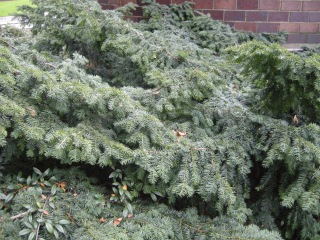Position: Light shade to full shade
Flowering period: Spring
Soil: Moist, well drained
Eventual Height: 20m
Eventual Spread: 10m
Hardiness: 6b, 7a, 7b, 8a, 8b, 9a, 9b
Family: Cephalotaxaceae
Torreya nucifera is a slow growing, long lived, evergreen tree with a conical habit when young. Its dark green leaves are needle like with a sharp tip, linear, up to 3cm long and 3mm broad. Its trunk may achieve a diameter of up to 1.5m. Its sub dioecious flowers are pollen cones, the male cones being globular and up to 6mm across and the female cones borne in clusters of up to 8. The female cones are wind pollinated and individual trees are self fertile. Its green/ purple fruit is a fleshy berry, ellipsoid, up to 2cm long and 1.5cm broad.
Torreya nucifera, commonly known as Kaya, Japanese Torreya or Japanese Nutmeg Yew, is native to southern Japan and an island off South Korea. In its native habitat it grows in woodlands and valley bottoms.
The etymological root of the binomial name Torreya is named after John Torrey (1796 – 1873), an American Botanist. Nucifera is derived from the Latin Nux meaning ‘nut’ and fero meaning ‘to bear’.
The landscape architect may find Torreya nucifera useful as a shade tolerant ornamental, evergreen specimen tree.
Ecologically, Torreya nucifera berries are attractive to some birds and mammals.
Torreya nucifera prefers moist, fertile, well-drained soils. It tolerates most pH of soil. It prefers moist soils.
Torreya nucifera requires little maintenance.











